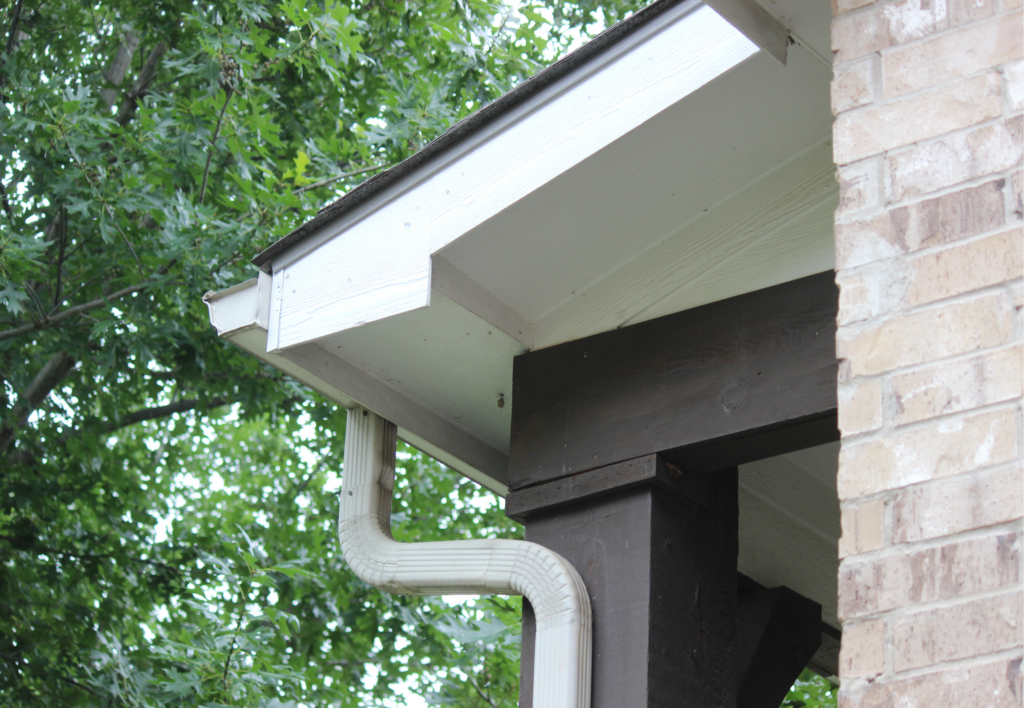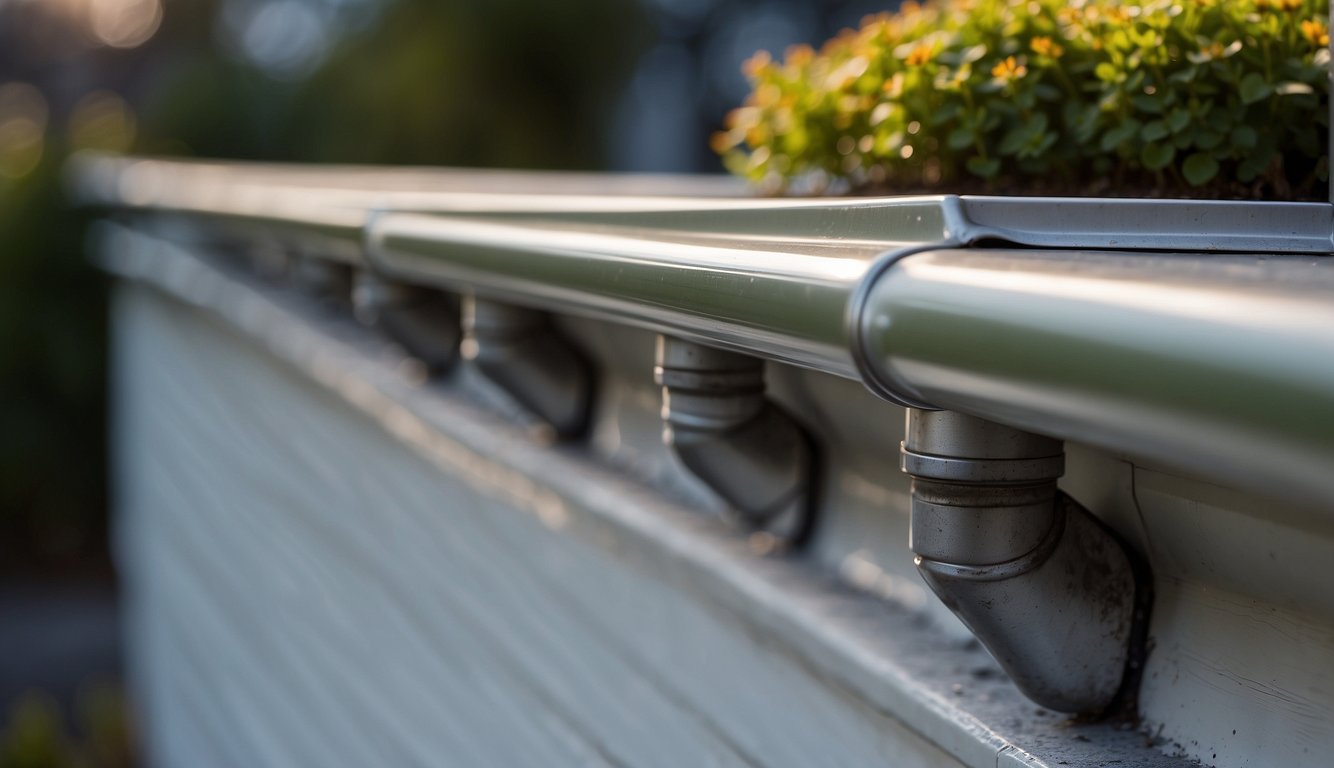How Many Downspouts for Gutters: Calculating Your Needs
When considering the installation of gutters on a home, it is essential to plan for the appropriate number of downspouts to ensure efficient rainwater management. Downspouts are the vertical pipes that channel water away from the gutters and the foundation of the house. We aim to strike a balance between enough downspouts to handle the water flow without installing more than what is necessary, as this could be cost prohibitive.
We generally recommend installing one downspout for every 20 to 40 feet of gutter length. The exact number can vary depending on factors such as the roof size, the gutter capacity, and the typical rainfall in the region. Larger gutters might need fewer downspouts as they can handle more water, whereas smaller gutters may require additional downspouts to prevent overflow. Additionally, homes in areas prone to heavy rainfalls might need more downspouts to cope with the volume of water.
Determining Gutter Size and Capacity
When planning for adequate drainage of your roof, it’s crucial to consider gutter size and capacity. This will ensure your gutters can handle the rainfall your home encounters.
Factors Influencing Gutter Sizing
In determining the right gutter size, we consider several factors. The climate in your area can dictate how much water your gutters need to channel away. Heavier rainfall requires larger gutters with higher capacity.
The square footage of your home’s roof is another key factor; bigger roofs gather more water, thus needing bigger gutters. A roof’s pitch can vastly affect water velocity, where steeper roofs, indicated by a higher roof-pitch factor, will cause water to flow faster and in larger amounts, necessitating larger gutters.

Calculating Roof Area and Rainfall Intensity
We estimate the drainage area by measuring the roof’s square footage, which then informs us of the gutter sizing. Use this simple calculation method:
- Measure the length and width of each roof plane.
- Calculate the square footage of each plane.
- Sum these areas for the total roof area.
Once we have the total roof area, we consider rainfall intensity, which is how much rain falls in an hour, typically expressed in inches per hour (in/hr). With this information, we can match the gutters to handle the expected water volume.
Gutter Style and Material Choices
For gutter style, K-style gutters are most common, and your choice between five and six-inch sizes will impact downspout size. Material choices for gutters include aluminum, copper, steel, and vinyl, each varying in durability, cost, and maintenance needs. When considering materials, we must balance longevity and performance with climate compatibility and cost efficacy, as some materials handle specific climates better than others. For example, aluminum gutters are rust-resistant and well-suited to most climates, while copper offers a higher-end aesthetic and exceptional durability.
Remember, the goal is to have a gutter system capable of managing the water volume from your roof without overflowing. Proper sizing is essential for preventing water damage to your home’s foundation and landscaping.
Downspout Specifications and Placement
To ensure effective water drainage, we need to focus on three key elements: sizing downspouts correctly, determining the appropriate number of downspouts, and positioning them to optimize performance. Let’s examine how these factors contribute to a robust gutter system.
Determining Downspout Size
- Assess Roof Size: Measure the dimensions of the roof to calculate the square footage. This helps determine how much rainfall the downspouts must handle.
- Consider Rainfall Intensity: Geographic location influences rainfall amounts, thus affecting downspout size. Areas with heavier rainfall require larger downspouts.
Table 1: Downspout Size Based on Roof Area
| Roof Area (sq ft) | Downspout Size |
|---|---|
| Up to 600 | 2×3 inches |
| 601 to 1,200 | 3×4 inches |
| Over 1,200 | 4×5 inches |
Calculating the Number of Downspouts
- Measure Gutter Lengths: Identify total gutter lengths to estimate how many downspouts are necessary.
- Spacing for Optimal Drainage: Aim for one downspout per every 35 feet of gutter to provide sufficient water flow and prevent overflow.
Positioning Downspouts for Optimal Performance
- Place Near Corners: Ideally, install downspouts at the corners of the house for direct water flow away from the foundation.
- Ensure Proper Slope: A 1/4 inch slope for every 4 feet of gutter towards downspouts assists in preventing clogs and backups.
- Avoid Obstructions: Position downspouts to avoid pathways and landscaping for safe and convenient water drainage.
Installation Techniques and Best Practices
In this section, we’re going to explore how to properly secure gutters and downspouts, ensure they have the correct slope and level, and choose the best tools and materials for the installation.
Securing Gutters and Downspouts to Fascia
To securely attach gutters and downspouts to the fascia board, it’s essential to use the correct hangers or brackets spaced every 24 inches. For extra support, screw in the hangers directly to the rafter tails. Ensure that the gutters are tightly fastened and that the downspouts are connected to the gutters with brackets to prevent detachment during harsh weather.
- Tools & Materials Needed:
- Brackets or hangers
- Screws
- Drill
- Sealant
Ensuring Proper Slope and Level
Gutters must have a slight slope towards the downspouts for effective water flow. A good rule of thumb is to aim for about 1/4 inch of slope for every 10 feet of gutter. Use a level to check this during installation. The gutters should not be perfectly level; otherwise, water will pool instead of draining.
- Measuring Slope:
- Level
- Measuring tape
- Chalk line (optional for marking)
Choosing the Right Tools and Materials
Having the right tools and materials on hand will streamline the installation process. Use a measuring tape to determine the length of gutter needed and to space your brackets evenly. Depending on gutter and downspout size, ensure all components are compatible. Use a sealant designed for gutter installation to prevent leaks.
Must-Have Tools:
- Measuring tape
- Level
- Sealant gun
- Drill
Material Considerations:
- Gutter size (5-inch for standard, 6-inch for larger roofs)
- Downspout size (3×4 inches for areas with heavy rainfall)
- Compatible sealant for weatherproofing joints
Maintenance and Troubleshooting
Effective maintenance and troubleshooting of gutter downspouts are essential to protect your home from water damage and erosion. This section covers the practical steps we can take to address common issues like leaks and blockages, and how regular cleaning can greatly enhance gutter performance.
Preventing and Fixing Leaks
- Inspection: Regularly check joints and seams for signs of leakage.
- Sealant Application: Apply a high-quality sealant to any small holes or cracks to prevent leaks.
Leaks in downspouts often occur at joints where sections connect. We seek out signs of moisture or water damage on the exterior of the downspout, indicating a potential leak. For minor leaks, we can typically resolve the issue with a waterproof sealant, ensuring that it is suitable for the material of the downspout, whether it be aluminum, PVC, or galvanized steel.
Avoiding and Managing Blockages
- Regular Inspection: Look out for debris buildup in gutters and downspouts.
- Install Gutter Guards: Gutter guards can help prevent blockage by keeping out leaves and debris.
Blockages can cause overflows, leading to potential water damage and erosion around the foundation. Regular inspections and removal of debris are essential. Installing gutter guards can be a preventive measure against blockages by preventing large debris from entering the system while allowing water to flow smoothly.
Downspout and Gutter Cleaning Strategies
- Frequency: Clean gutters and downspouts at least twice a year; typically in the spring and fall.
- Method: Remove debris by hand or with a gutter scoop and flush the system with a hose to clear out smaller particles.
Cleaning is vital for preventing leaks and blockages that can cause overflows. We recommend cleaning gutters and downspouts at least twice a year, with additional checks after heavy storms. Using a ladder safely, we clear out leaves and debris by hand or using a gutter scoop, and subsequently flush the gutters with a hose to ensure water can flow freely through the system.
Enhancements and Accessories

When we optimize our gutter system, enhancements and accessories not only improve functionality but can also contribute to aesthetic appeal and maintenance efficiency.
Incorporating Gutter Guards and Screens
Gutter guards and screens play an essential role in reducing the maintenance needs of your gutter system. By installing these, you minimize the accumulation of debris, such as leaves and twigs, which can lead to blockages in your downspouts. This proactive measure can prevent the sagging and overflow of gutters, ensuring they remain clean and functional.
- Types of Gutter Guards:
- Mesh guards: Allow water through while blocking debris.
- Solid guards: Cover the gutters and let water flow over the edge and into the gutter.
Rain Barrels and Water Collection
Utilizing rain barrels is a smart way to collect and conserve water runoff from your gutters for gardening and other outdoor uses. This accessory can be easily connected to your downspout using an elbow and requires an overflow mechanism to manage excess water. Connecting a rain barrel also has the benefit of reducing water load on your system, mitigating potential for expansion and strain on brackets and joints.
- Benefits:
- Conservation of water.
- Reduction in water bills.
Aesthetic Options and Add-ons
The aesthetics of our gutter system can be enhanced with various add-ons that combine style with utility. Downspout brackets not only secure the downspout to your home but can also be decorative. End caps give a finished look to gutters, and soffits, which cover the underside, can be matched to your home’s trim. Selecting materials and colors that complement your home’s exterior can add curb appeal and value.
- Decorative Elements:
- Decorative brackets: A variety of designs and finishes.
- Copper or ornate aluminum downspouts: Add elegance and style.
In summary, these enhancements and accessories help us manage the efficiency, appeal, and longevity of our gutter systems.
Let Us Know How We’re Doing!
Did this expertly prepared resource answer your question?
Do you have another question about home maintenance, home improvement projects, home appliance repair, or something else?
Get more information, send in questions and keep the discussion going by contacting the I’ll Just Fix It Myself company customer service team at at 1-800-928-1490 or Email us at [email protected]
